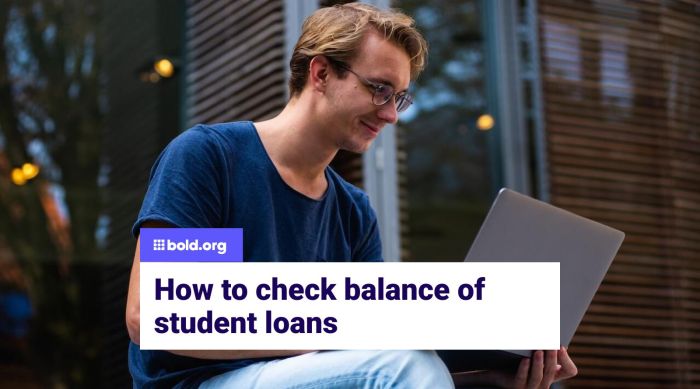
Navigating the world of student loans can feel overwhelming, a labyrinth of federal programs, private lenders, and repayment options. This guide cuts through the complexity, providing a clear path to understanding your student loan options, locating your loan information, and developing a manageable repayment strategy. Whether you’re a recent graduate facing your first loan payment or a seasoned borrower seeking to optimize your repayment plan, this resource offers practical advice and actionable steps to empower you in managing your student loan debt effectively.
From deciphering the differences between federal and private loans to exploring various repayment plans and understanding loan forgiveness programs, we’ll equip you with the knowledge and tools to confidently navigate this crucial financial journey. We’ll cover everything from accessing your loan details online to effectively budgeting and managing your repayments, ensuring you’re well-prepared to handle your student loan responsibilities.
Understanding Student Loan Types

Navigating the world of student loans can feel overwhelming, but understanding the fundamental differences between loan types is crucial for making informed financial decisions. This section will clarify the distinctions between federal and private student loans, highlighting key aspects to consider before borrowing.
Federal Student Loans
Federal student loans are offered by the U.S. government through various programs. These loans generally offer more borrower protections and flexible repayment options compared to private loans. Eligibility is determined by factors such as enrollment status, financial need (for some programs), and U.S. citizenship or eligible non-citizen status.
Examples of Federal Loan Programs
Several federal loan programs cater to different student needs. The Federal Direct Subsidized Loan, for instance, is available to undergraduate students demonstrating financial need. Interest does not accrue while the student is enrolled at least half-time. The Federal Direct Unsubsidized Loan is available to both undergraduate and graduate students, regardless of financial need, but interest accrues from the time the loan is disbursed. Finally, the Federal Direct PLUS Loan is available to graduate students and parents of dependent undergraduate students, but requires a credit check.
Private Student Loans
Private student loans are offered by banks, credit unions, and other private lenders. These loans are not backed by the government, meaning they often come with higher interest rates and less borrower protection. Eligibility depends largely on the applicant’s credit history and creditworthiness (often requiring a co-signer if the applicant lacks sufficient credit history).
Comparison of Federal and Private Student Loans
The following table summarizes the key differences between federal and private student loans:
| Feature | Federal Loans | Private Loans |
|---|---|---|
| Interest Rates | Generally lower, fixed or variable | Generally higher, variable |
| Repayment Terms | Various options, including income-driven repayment plans | Typically shorter repayment periods, fewer options |
| Loan Forgiveness | Potential for forgiveness through certain programs (e.g., Public Service Loan Forgiveness) | Limited or no loan forgiveness options |
| Borrower Protections | Stronger borrower protections, including deferment and forbearance options | Fewer borrower protections |
Locating Your Loan Information

Understanding where your student loan information resides is crucial for effective repayment planning and managing your debt. This section details how to access both federal and private student loan information, providing you with the tools to effectively track your loan details.
Accessing your student loan information is a straightforward process, although the methods differ depending on whether your loans are federal or private.
Accessing Federal Student Loan Information
The National Student Loan Data System (NSLDS) is the central database for federal student aid. It provides a comprehensive overview of your federal student loans, including loan amounts, interest rates, and repayment schedules. To access your NSLDS information, you’ll need your Federal Student Aid (FSA) ID, which is a username and password used to access federal student aid websites. Once you’ve logged in, you’ll be able to view a summary of your federal student loans. The NSLDS website provides clear instructions and assistance if you encounter any difficulties.
Accessing Private Student Loan Information
Locating information on your private student loans requires a slightly different approach. Unlike federal loans, which are centralized in the NSLDS, private student loans are managed by various private lenders. Therefore, you’ll need to contact each lender individually to obtain your loan details. Keep a record of all your lenders and their contact information. This may include visiting their websites, reviewing loan documents, or calling their customer service departments.
Obtaining a Loan Summary
A loan summary typically includes your principal balance, interest rate, repayment schedule (including monthly payment amount and loan term), and any accrued interest. For federal loans, this information is readily available through the NSLDS. For private loans, you must request this information directly from your lender. Most lenders provide this information online through your account portal; otherwise, contacting customer service is necessary. It is advisable to request a loan summary from each lender at least annually to track your progress.
Organizing Your Loan Information
Effective organization is key to managing your student loans. Consider creating a spreadsheet or using a personal finance software program to consolidate all your loan information. Include the following details for each loan:
- Lender Name: (e.g., Sallie Mae, Discover, Your University’s Credit Union)
- Loan Type: (e.g., Federal Direct Subsidized Loan, Private Unsubsidized Loan)
- Loan Number: (A unique identifier for each loan)
- Principal Balance: (The amount you still owe)
- Interest Rate: (The annual percentage rate charged on your loan)
- Monthly Payment: (Your scheduled monthly payment amount)
- Repayment Start Date: (The date your repayment begins)
- Loan Term: (The length of time you have to repay the loan)
- Contact Information: (Phone number, website, and email address of the lender)
Regularly updating this information ensures you always have a clear picture of your debt and allows you to proactively manage your repayment strategy.
Final Conclusion

Successfully managing student loan debt requires proactive planning, informed decision-making, and a commitment to responsible financial practices. By understanding the various loan types, accessing your loan information efficiently, exploring repayment options, and seeking assistance when needed, you can take control of your financial future. Remember that numerous resources are available to support you throughout this process, from online tools and government programs to financial counselors and non-profit organizations. Take advantage of these resources, and remember that proactive management is key to achieving financial well-being.
General Inquiries
What if I can’t find my loan servicer?
Contact the National Student Loan Data System (NSLDS) or your lender directly for assistance locating your servicer information.
Can I consolidate my federal and private loans?
Generally, you cannot consolidate federal and private loans together. However, you may be able to consolidate multiple federal loans into a single loan.
What happens if I miss a student loan payment?
Missing payments can result in late fees, damage to your credit score, and potentially lead to default on your loan, impacting your future borrowing ability.
Are there any programs that help with student loan debt for specific professions?
Yes, programs like Public Service Loan Forgiveness (PSLF) offer loan forgiveness for those working in public service jobs. Eligibility requirements vary depending on the program.
